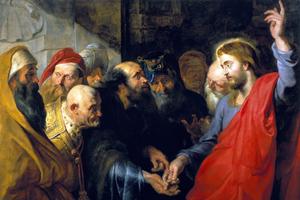4th Sunday of Easter: Good Shepherd Sunday
SCRIPTURES & ART: Today’s Gospel speaks of how the sheep should act, but it’s also an important lesson for shepherds

The Fourth Sunday of Easter is traditionally called “Good Shepherd Sunday” because that is the theme of the Gospel.
That had previously been the Gospel of what we today call the Third Sunday of Easter but, during the revision of the Lectionary (the Church’s book of readings) after Vatican II, the Gospel of the Good Shepherd was pushed off one week to allow more Gospels of Jesus’ post-Easter appearances to the Apostles to be read (e.g., Jesus on the Road to Emmaus last Sunday).
Today also marks a shift in the post-Easter Gospel readings. Whereas the previous two Sundays focused more on concrete events in terms of Jesus’ post-Resurrection appearances, the emphasis today and for the upcoming Sundays moves to Jesus’ teaching about his impending Ascension and the gift of the Holy Spirit at Pentecost. (It makes a column about “Scripture and Art” harder to write, as few artists paint abstract theological concepts.) The First Readings remain historical accounts of the life of the early Church from the Acts of the Apostles.
Jesus as Good Shepherd, the guardian of the sheepfold, is also an ecclesiological text: this is a theology of the Church. The Church is Christ’s sheepfold. There are no lone sheep: the sheep who wanders from the flock, from the sheepfold, is in danger. He’s not free, out to “define one’s own concept of existence, of meaning, of the universe and of the mystery of human life.” He’s lost, exposed and in danger. He needs to be rescued. He needs to be saved.
There is an order to the sheepfold, and it’s the Good Shepherd who maintains it. He’s the gatekeeper. He opens … and closes. His voice is normative: the sheep “hear his voice” and follow him. The sheep know to listen for the voice they know, not the stranger’s siren call.
In grouping them as a flock and keeping them in a sheepfold, the Good Shepherd does not suppress their freedom or trample on their “autonomy.” The Good Shepherd and the Gate guarantee the safety of the sheep, not out of mean considerations but “that they might have life and have it more abundantly.” As the Second Reading puts it, Christ is “the shepherd and guardian of your souls” (1 Peter 2:25) who has brought you back from the strays.
The image of the shepherd had a long and mixed tradition in the Bible. We hear an echo of that in the Responsorial Psalm — “the Lord is my shepherd” (Psalm 23). Shepherds already appear in Bethlehem. The Bible also recognizes Bad Shepherds, whom Jesus today calls “thieves and marauders” that only divide and confuse the sheep. Elswhere, Jesus makes clear the sheep are “his,” i.e., they belong to him, and it is that relationship — and not the relationship of a hireling — that makes a Good Shepherd.
Today’s Gospel speaks of how the sheep should act, but it’s also an important lesson for shepherds: bishops, priests, all who have leadership roles in the Church. Their responsibility is to be like the Good Shepherd, speaking his voice and protecting the integrity of his sheepfold, out front leading.
Jesus is also, paradoxically, both Shepherd and Sheep. He is the “Lamb of God,” the spotless Lamb offered on the cross who takes away the sins of the world.
This theme is captured in today’s painting, by the late 19th-century British artist Sybil Parker. Her “Door of the Fold,” an oil painting from 1895, presents Jesus in his gatekeeper function, the one who opens the door of the fold. Under his right hand — the hand of authority — five sheep venture out, taking in the environment but in trust toward their Shepherd. At his left foot, a sheep lies down in peace (see Psalm 4:8). A little lamb — a recovered lost sheep? — reclines on Jesus’ left arm. Jesus looks with care at his charges.
A priest has noted the correlation between the Good Shepherd and his role as the sacrificial Lamb of God. Note that, over Christ’s shoulder, the wood of the sheep shed forms a cross. To his left are elements of his Passion: the rock hill (of Calvary), the scarlet robe, the inscription. The purity of the scene — Christ in white, the sheep washed white as wool, contrasts to strong color of the crimson robe: “Though your sins be like scarlet, they may become white as wool; though they be red as crimson, they may become white as wool” (Isaiah 1:18).
In the rafters are grapes and wheat, allusions to the Eucharist, where that sacrifice is perpetuated. Two doves nestle in the woodwork, reminding us of the two turtle doves offered at Christ’s Presentation, the stipulated sacrifice of the poor (Leviticus 14:22, Luke 2:24).

















